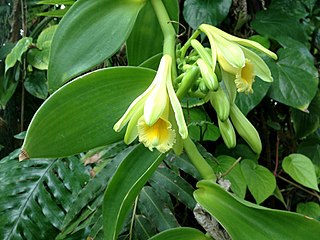
Vanilla is a spice derived from orchids of the genus Vanilla, primarily obtained from pods of the flat-leaved vanilla (V. planifolia).

Vanillin is an organic compound with the molecular formula C8H8O3. It is a phenolic aldehyde. Its functional groups include aldehyde, hydroxyl, and ether. It is the primary component of the extract of the vanilla bean. Synthetic vanillin is now used more often than natural vanilla extract as a flavoring in foods, beverages, and pharmaceuticals.

Vanilla extract is a solution made by macerating and percolating vanilla pods in a solution of ethanol and water. It is considered an essential ingredient in many Western desserts, especially baked goods like cakes, cookies, brownies, and cupcakes, as well as custards, ice creams, and puddings. Although its primary flavor compound is vanillin, pure vanilla extract contains several hundred additional flavor compounds, which are responsible for its complex, deep flavor. By contrast, artificial vanilla flavor is solely made up of artificially derived vanillin, which is frequently made from a by-product of the wood pulp industry. Because of the way that vanilla extract is made, there is no possible way for it to be colorless or clear. Therefore, any clear vanilla flavoring is artificial.
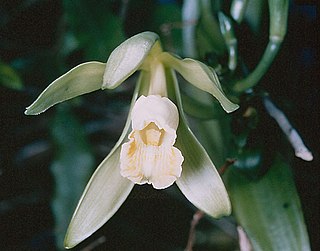
Vanilla, the vanilla orchids, forms a flowering plant genus of about 110 species in the orchid family (Orchidaceae). The most widely known member is the flat-leaved vanilla, native to Mexico and Belize, from which commercial vanilla flavoring is derived. It is the only orchid widely used for industrial purposes in flavoring such products as foods, beverages and cosmetics, and is recognized as the most popular aroma and flavor. The key constituent imparting its flavour is the phenolic aldehyde, vanillin.
Domesticated plants of Mesoamerica, established by agricultural developments and practices over several thousand years of pre-Columbian history, include maize and capsicum. A list of Mesoamerican cultivars and staples:
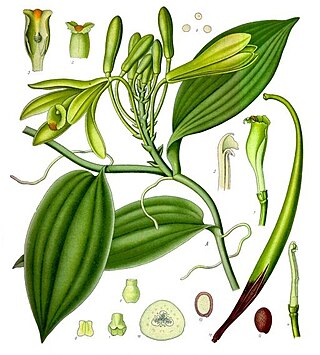
Vanilla planifolia is a species of vanilla orchid native to Mexico, Central America, Colombia, and Brazil. It is one of the primary sources for vanilla flavouring, due to its high vanillin content. Common names include flat-leaved vanilla, and West Indian vanilla. Often, it is simply referred to as "the vanilla". It was first scientifically named in 1808. With the species' population in decline and its habitats being converted to other purposes, the IUCN has assessed Vanilla planifolia as Endangered.

Edmond Albius was a horticulturalist from Réunion. Born into slavery, Albius became an important figure in the cultivation of vanilla. At the age of 12, he invented a technique for pollinating vanilla orchids quickly and profitably. Albius's technique revolutionized the cultivation of vanilla and made it possible to profitably grow Vanilla planifolia away from its native habitat.

Creosol is a chemical compound with the molecular formula C8H10O2. It is one of the components of creosote. Compared with phenol, creosol is a less toxic disinfectant.

Vanilla pompona is a species of vanilla orchid. It is native to Mexico and northern South America, and is one of the sources for vanilla flavouring, due to its high vanillin content.
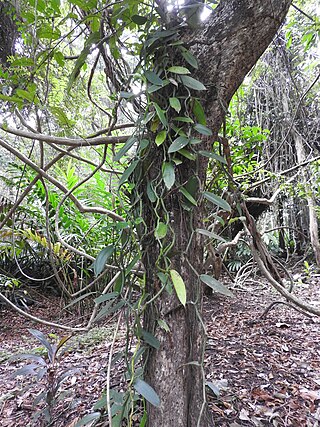
Vanilla andamanica is an endangered wild relative of commercial vanilla, Vanilla planifolia, the source of vanilla essence. It grows in the Andaman and Nicobar Islands, India in the Bay of Bengal., and classified as a Vulnerable species (VU) by the IUCN Red List.

Vanilla polylepis is a climbing orchid species in the plant family Orchidaceae. It is native to tropical Africa, with a range spanning the width of the continent, from Kenya to Angola. It grows in high-altitude evergreen and swamp forests between 1,200–1,500 m (3,900–4,900 ft) and is often found growing on trees bordering rivers and waterfalls. Plants produce bright green, fleshy stems, 10–12 mm (0.39–0.47 in) in diameter, with large, glossy leaves. White, aerial roots form on the stems allowing the orchids to attach themselves to trees for support. As with many orchids, they produce showy flowers, which in the case of V. polylepis are white and yellow with a pink to maroon blotch. This differentiates them from similar species. They have seedpod-like fruits, called capsules, which produce a distinctive aroma as they dry. They are closely related to the well-known species Vanilla planifolia, whose seed pods are used commercially in the production of vanilla flavouring.

Mesir Macunu is a traditional Turkish sweet associated with the city of Manisa. Earlier versions of Mesir macunu were not sweet, but rather spicy in flavor.

Vanilla production contributes to the local economy of French Polynesia. Although it was a major export crop after its introduction by the French in 1848, vanilla is no longer a significant export product.

Vanilla × tahitensis is a hybrid orchid in the genus Vanilla. It was first described by the botanist John William Moore in 1933 from Raiatea in the Society Islands, where it was found growing on trees, having escaped from cultivation.
Holotrichia rufoflava is a species of dung beetle found in South India and Sri Lanka.
Curing is a technique for preservation of vegetable material. It involves storing the material in a prescribed condition immediately after harvest.
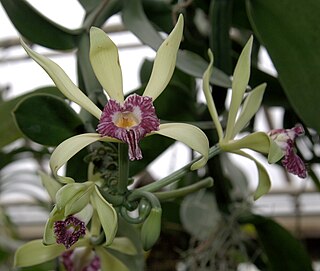
Vanilla imperialis is an orchid found from Sierra Leone eastward to Ethiopia and southward to Tanzania and Angola. It is a root-climbing vine to about 65 feet in height, with a root emerging just above each leaf. Although not as tall as the common vanilla, it is up to a full inch in thickness; the most massive Vanilla species, and the largest of all African orchids. The inflorescence is an unbranched raceme up to six inches long. The flowers are six inches wide with the white or yellow petals and sepals three inches (8 cm) long by 0.75 inch (1.8 cm) in width. The labellum is 2.5 inches in length with the far end flared and pink or purple. Most of the labellum is fused to the column, forming a tube. Each flower is open for at least two days( Chambers says seven days).

Vanilla odorata, also known as vanilla tlatepusco, is a species of flowering plant in the family Orchidaceae, native to southern Mexico, Central America, and tropical South America. With Vanilla planifolia it is a parent of the vanilla crop species Vanilla × tahitensis.














